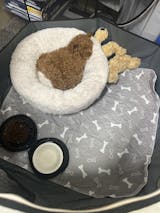How Long Should You Walk Your Dog Daily
Dogs must be physically and mentally active to maintain good health. Of course, the most popular form of canine exercise is walking. But how long should you walk a dog?
The quick response is: for however long they want! However, if you want more information, the entire details on how long to walk your dog are provided below.
Benefits of Walking Your Dog
Our discussion of how long you should walk a dog doesn't make sense if you don't understand why it's necessary, right? Dog walks are beneficial for your dog's health and your wellness, despite the fact that you probably don't need to urinate on just about everything you cross! Therefore, regular walks are important and benefit the dog's health in several ways.
Improves joint health: Long lengths of time spent at home with your dog might be hard on their joints. The motion of walking keeps the animal's joints mobile and maintains its physical fitness.

Digestive health: When dogs go for walks, they stretch, urinate, and defecate throughout the neighbourhood, all of which are beneficial to their health. This keeps the dogs' digestive and urogenital systems healthy and helps their bodies function normally.
Weight loss: Walking is an excellent way to burn calories. Regular walks help your dog burn excess calories and maintain a healthy weight.
How Long Should You Walk A Dog?
Your dog's breed, age, health, fitness level, and personality all play a role in how long you should walk a dog. Consider these queries -
Which species are they? The breed of your dog has a big impact on how energetic they are by nature. Some require as little as one to two hours of exercise every day, while others require more than two hours, and some—mostly working breeds—need substantially more activity in addition to constant mental stimulation. Flat-faced breeds like Pugs, Bulldogs and Shih Tzus require the same amount of exercise as any other dog, but frequently have breathing problems because of the form of their faces.
What is their age? In order to safeguard your dog's joints as they grow, start introducing exercise to them gradually. It's crucial to make sure kids remain active and fit as adults. You might notice that your dog needs a little less activity as they age.

Puppy: You won't be able to carry pups very far because they have less energy than adult dogs and need to go potty every two to four hours, so you'll need to take them out more regularly. Work on your skills with them in a safe area, like the backyard. Begin modestly by pacing your puppy back and forth in front of the home, then progress from there.
Adult Dog: A 10 to 15-minute stroll is a wonderful place to start if your dog hasn't been very active or is out of shape. Just as with puppies, make the walk brief and upbeat. See if your dog is walking ahead of you or trailing behind you by keeping an eye on their pace. It could be necessary to change your pace.
Senior Dog: Exercise is a great approach to keep your dog fit and active if they are willing and able to walk. In order to maintain their level of stimulation, elderly dogs can benefit from being exposed to new sights, sounds, and smells.
Do they suffer from any health issues? Since sleeping is a crucial component of healing, your dog won't need as much exercise if they are ill or injured. Rest them as often as your veterinarian recommends, and find other methods to occupy them to prevent boredom and frustration.

Dogs should engage in physical activity for between 30 minutes and two hours each day. Although you can do it all at once, most dog parents divide it into two or three daily walks because of the busy schedule. A decent general guideline is to walk your dog for a half hour at a time. However, there is no precise recipe. Begin with two easy 30-minute walks, one in the morning and one before dinner. The distance you can walk your dog is really up to them as long as they're comfortable.
Safety Measurements to Take Before The Walk
Walking your dog is always exciting. But if you don't take the right precautions, the delightful occasion could become a nightmare. We have provided you with a list of simple guidelines.
Obtain your dog's veterinarian's approval before starting any new physical activity. This is crucial for growing pups with underdeveloped joints as well as senior dogs who may suffer from joint problems like arthritis.
Invest in quality exercise gear. It's crucial to have a strong leash if you want to exert real control over your dog. To prevent the leash from slipping out of your hand, wrap it around your palm. A nylon training leash from DryPaws is excellent for walking. It is a heavy-duty weaved nylon leash so your dog can't chew it. Also, a skin-friendly collar would be great.

Examine those paws. It is a good idea to examine your dog's paws after a stroll. Look for bruises, wounds, and foreign objects such as cockleburs or splinters. After the walk, carefully clean them.
Be ready for the cleanup process. A lengthy, leisurely walk is a fantastic opportunity for your dog to relieve himself. Make sure your dog stays off of your neighbour's grass by being a responsible dog owner. Bring a scooper with you for simple cleanup.
Remain hydrated. Provide refreshments frequently, especially if you're taking lengthy treks in the summer. Do not share your power drink with dogs because human sports drinks are not designed for canines.
Warm-up and cool down. Before starting a long walk, give your dog some time to warm up his muscles. Allow him to enjoy the flowers and use the restroom. His curiosity will be satisfied, and you'll make fewer bathroom breaks while out walking. You should both take a moment to cool down while you walk more slowly for the remainder of your exercise session.
What Else Can You Do With Your Dog
A great method to maintain your dog's mental and physical well-being is to change up their schedule. Try some of the following ideas if you're seeking inspiration:

Swimming: If your dog likes the water, swimming is a terrific option and is also quite gentle on their joints. Follow water safety precautions to keep your dog safe whether you're in a pool, the sea, a river, or a lake.
Running: Make sure you introduce running to your four-legged pal gradually if you want to keep them both healthy. Try incorporating brief periods of light jogging into your regular walk to start, then work your way up to larger stretches over time.
Play: Every dog should engage in play daily. Playing a game is an easy but efficient approach to keep your dog happy and active, while it doesn't substitute a good walk. Depending on their breed and attitude, your dog may prefer to play tug of war, hide and seek, chase and retrieve toys, or sniff out their favourite item in a scent game.

Agility: A fun way to exercise your dog is through agility, especially if they enjoy challenges and have an active mind. It entails teaching your dog to navigate a maze that includes hurdles, tunnels, and even seesaws. It's a fantastic opportunity to strengthen your relationship with your dog and socialise them with other canines.
Hiking: A great way to spend time with your dog is to go hiking, but before you start, you need to make sure the route is appropriate for your dog and that they are healthy and fit enough to complete the trek. Always estimate the length of the hike and steer clear of particularly difficult climbing and steep areas.
Cycling: High-energy canine breeds including Huskies, Collies, Pointers, and Dalmatians benefit greatly from cycling as exercise. However, it's critical to gradually increase your dog's fitness, make sure they get regular rest and watch that you don't push them too hard because of the speed and endurance required to keep up with a bike. Keep in mind to bring lots of water, and make sure the trip is done before you set off. To be under your control, it's also crucial that your dog has been trained to keep a safe distance from your bike and has a strong recall.
The Bottom Line
We hope you now have a better idea of how long you should walk your dog. Every dog requires daily exercise to maintain happiness and health. Start gently while establishing a pattern for taking your dog for walks. As they gain strength, add longer walks after carefully monitoring their reactions. Your dog should be drowsily fatigued but not worn out. And keep in mind that increased exercise does not indicate a need for additional meals! Maintain regular veterinary checkups as well.
















